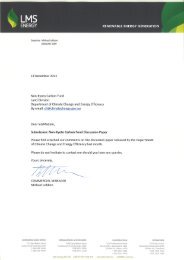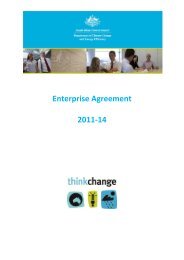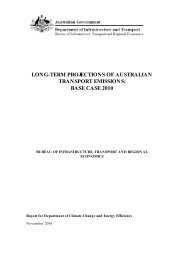Implications of Climate Change for Australia's World Heritage ...
Implications of Climate Change for Australia's World Heritage ...
Implications of Climate Change for Australia's World Heritage ...
You also want an ePaper? Increase the reach of your titles
YUMPU automatically turns print PDFs into web optimized ePapers that Google loves.
IMPLICATIONS OF CLIMATE CHANGE FOR AUSTRALIA’S WORLD HERITAGE PROPERTIES: A PRELIMINARY ASSESSMENT<br />
10. Mammal species endemic to the Wet Tropics <strong>of</strong> Queensland considered vulnerable to a 1.0 °C rise in<br />
temperature. For these species a loss <strong>of</strong> 50% <strong>of</strong> their core environment is predicted (Adapted from:<br />
Williams et al. 2003). 116<br />
11. Bioclimatic characteristics <strong>of</strong> bird species endemic to the Wet Tropics <strong>of</strong> Queensland<br />
(Crome & Nix 1991). Species are listed in order <strong>of</strong> vulnerability. 117<br />
12. Temperature and rainfall change based on a high greenhouse gas emissions scenario 130<br />
13. Current estimates <strong>of</strong> selected seabird populations on Heard and McDonald Islands, their<br />
population trends, and IUCN status (Birdlife International 2000; IUCN 2007). Errors <strong>of</strong> estimates<br />
are unknown. (Source: Woehler 2006: 129) 136<br />
14. Average annual rainfall <strong>for</strong> 2030 relative to 1990 <strong>for</strong> Australia’s <strong>World</strong> <strong>Heritage</strong> properties<br />
(adapted from: CSIRO 2006). Note: does not include all <strong>World</strong> <strong>Heritage</strong> properties, e.g.<br />
Lord Howe Island, Macquarie Island, Heard and McDonald Islands, and Shark Bay. 199 199<br />
15. Summary <strong>of</strong> climate change scenarios by 2030 (as an estimate <strong>of</strong> change) <strong>for</strong> each <strong>World</strong> <strong>Heritage</strong><br />
region derived from CSIRO climate modelling <strong>for</strong> Australia relative to 1990 (Source: CSIRO 2006).<br />
Figures are based on a ‘high’ greenhouse gas emissions scenario (the A1FI scenario (IPCC 2000)). 201<br />
Boxes<br />
Box 1. Natural heritage criteria (ix) and (x) 22<br />
Box 2. Natural heritage criteria (vii) and (viii) 25<br />
Box 3. Cultural heritage listing criteria (iii) to (vi) 27<br />
Box 4. Cultural heritage listing criteria (i) and (ii) 28<br />
Box 5. Coral vulnerability and thresholds 58<br />
Abbreviations<br />
AAD Australian Antarctic Division<br />
AGO Australian Greenhouse Office (now the Department <strong>of</strong> <strong>Climate</strong> <strong>Change</strong>)<br />
BOM Bureau <strong>of</strong> Meteorology<br />
CSIRO Commonwealth Scientific and Industrial Research Organisation<br />
DCC Department <strong>of</strong> <strong>Climate</strong> <strong>Change</strong><br />
DEH Department <strong>of</strong> the Environment and <strong>Heritage</strong> (now the Department <strong>of</strong> the Environment, Water,<br />
<strong>Heritage</strong> and the Arts)<br />
DEWHA Department <strong>of</strong> the Environment, Water, <strong>Heritage</strong> and the Arts<br />
EAC East Australian Current<br />
ENSO El Niño Southern Oscillation<br />
EPBC Environment Protection and Biodiversity Conservation<br />
GBRMPA Great Barrier Reef Marine Park Authority<br />
GIS geographic in<strong>for</strong>mation systems<br />
IPCC Intergovernmental Panel on <strong>Climate</strong> <strong>Change</strong><br />
UNESCO United Nations Educational, Scientific and Cultural Organization<br />
ix






